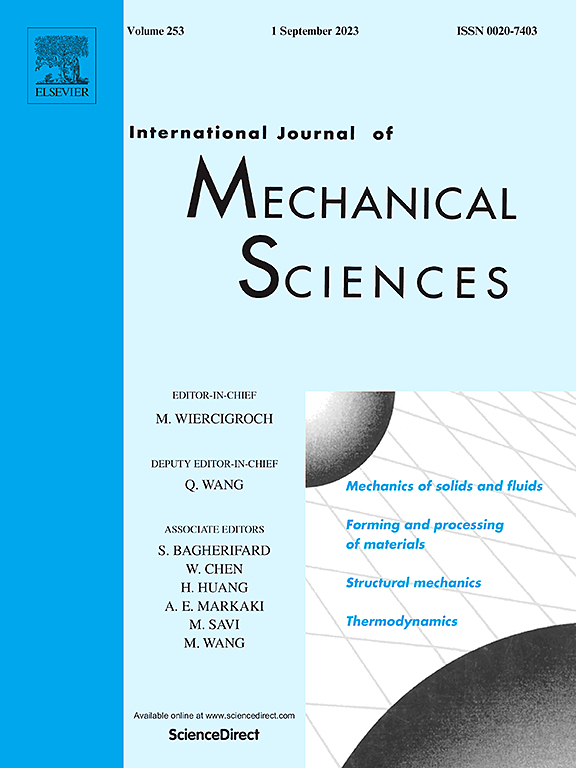基于 GAN 的结构超材料逐步全场力学预测模型
IF 7.1
1区 工程技术
Q1 ENGINEERING, MECHANICAL
International Journal of Mechanical Sciences
Pub Date : 2024-10-08
DOI:10.1016/j.ijmecsci.2024.109771
引用次数: 0
摘要
机械超材料的特征是具有显著宏观机械特性的独特单元,探索这种材料至关重要。依赖生物启发结构的传统方法在一定程度上缺乏广阔的设计空间和可控性,尤其是在实际需求没有生物对应物的情况下。因此,迫切需要推进单元单元的扩展设计方法,以满足不同的实际需求。受建筑材料的启发,潜在设计范式因其广泛的可能性和独特的分布而备受瞩目。然而,宽广的设计空间在准确评估不同单元的变形历史和应力状态方面面临挑战,需要通过实验或模拟进行验证,并对设计施加效率限制。利用模仿腐蚀算法和计算模拟生成的模式,构建了基于 GAN 的机器学习代理模型,以准确高效地预测建筑单元的变形历史和应力场,其中提出了逐步映射策略,以增强图像处理中对机械信息的理解。在涵盖已探索领域和若干未探索领域的不同案例中,该模型实现了有效预测,证明了该模型在推断时域和设计空间预测方面的稳健性和适应性。所提出的方法证明了其有效性、稳定性和通用性,开创了在稀疏数据环境中预测架构超材料力学历史的解决方案,从而克服了训练集的局限性。本文章由计算机程序翻译,如有差异,请以英文原文为准。

A GAN-based stepwise full-field mechanical prediction model for architected metamaterials
The exploration of mechanical metamaterials, characterized by unique unit cells with significant macroscopic mechanical properties, is of crucial importance. Traditional methods relying on bioinspired structures lack broad design space and controllability to some extent, especially when practical requirements have no biological counterparts. Hence, there is a pressing need to advance methodologies for the expansive design of unit cells, catering to diverse practical demands. Inspired by architected material, a latent design paradigm gains prominence for its extensive possibilities and unique distribution. However, wide design space faces challenges in accurately assessing the deformation history and stress states of diverse units, requiring validation through experiments or simulations, and imposing efficiency constraints on design. Using patterns generated by a mimetic corrosion algorithm and computational simulations, a GAN-based machine learning surrogate model is constructed to predict the history of deformation and stress fields of architected unit cells with accuracy and efficiency, in which a stepwise mapping strategy is proposed to augment comprehension of mechanical information in image processing. In distinct cases covering both explored domains and several unexplored domains, the model achieves effective predictions, demonstrating the robustness and adaptability of the model in extrapolating predictions of both time domain and design space. The proposed method demonstrates efficacy, stability, and generalizability, pioneering a solution for the mechanical history prediction of architected metamaterials in a sparse data setting, thereby overcoming the limitations of the training set.
求助全文
通过发布文献求助,成功后即可免费获取论文全文。
去求助
来源期刊

International Journal of Mechanical Sciences
工程技术-工程:机械
CiteScore
12.80
自引率
17.80%
发文量
769
审稿时长
19 days
期刊介绍:
The International Journal of Mechanical Sciences (IJMS) serves as a global platform for the publication and dissemination of original research that contributes to a deeper scientific understanding of the fundamental disciplines within mechanical, civil, and material engineering.
The primary focus of IJMS is to showcase innovative and ground-breaking work that utilizes analytical and computational modeling techniques, such as Finite Element Method (FEM), Boundary Element Method (BEM), and mesh-free methods, among others. These modeling methods are applied to diverse fields including rigid-body mechanics (e.g., dynamics, vibration, stability), structural mechanics, metal forming, advanced materials (e.g., metals, composites, cellular, smart) behavior and applications, impact mechanics, strain localization, and other nonlinear effects (e.g., large deflections, plasticity, fracture).
Additionally, IJMS covers the realms of fluid mechanics (both external and internal flows), tribology, thermodynamics, and materials processing. These subjects collectively form the core of the journal's content.
In summary, IJMS provides a prestigious platform for researchers to present their original contributions, shedding light on analytical and computational modeling methods in various areas of mechanical engineering, as well as exploring the behavior and application of advanced materials, fluid mechanics, thermodynamics, and materials processing.
 求助内容:
求助内容: 应助结果提醒方式:
应助结果提醒方式:


